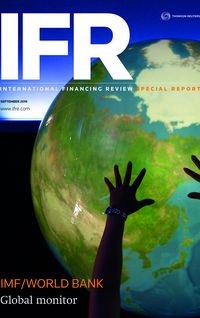Demand for Russian corporate debt is in evidence, although supply has been slow to appear.
Speculation has been bubbling away since the St. Petersburg Economic Forum in June that a glut of Russian corporate Eurobond deals would flood the markets, although the flow so far has been light.
However, three names which could herald a pick-up in activity towards year-end are power utility company EuroChem, corporate O1 Properties and Russia’s largest privately owned bank, Otkritie.
EuroChem was mentioned during the St. Petersburg forum as a possible Eurobond issuer following a spate of deals that concentrated on liability management, and has mandated for an international bond.
It looked then that there would be a flurry of deals from Russian corporates, with PhosAgro, Polyus Metals and TMK all in the frame, but summer proved to be a window on a thin pipeline.
“We’ve not seen as much supply as we’d hoped [from Russia], although the demand is evident,” said a London-based DCM banker. “The domestic market has lots of cash available, with many companies cash-rich, which is in part a function of why they have been doing liability management. On balance, the liability management exercises have seen better take-up when investors were afforded the option to switch into a new security.”
Indeed, Sberbank analysts believe that EuroChem could follow the path set by other Russian corporate issuers and undertake a liability management exercise alongside the new issuance.
“We think the issuer might offer a partial exchange of the outstanding EuroChem 17 for a new bond, similar to the Sovcomflot, NLMK and Evraz placements in June,” they said.
O1 Properties (B1/B+) hired Credit Suisse, Goldman Sachs, JP Morgan, RBI and VTB Capital to arrange investor meetings ahead of a potential US dollar 144A/Reg S Eurobond, with a roadshow that ran from September 9–15, taking in Moscow, Switzerland, London and New York.
The company is one of the largest owners and managers of Prime A/A office properties in Moscow.
Otkritie (Ba3/BB–), meanwhile, mandated Citigroup and Societe Generale as joint global coordinators on a potential US dollar Reg S offering, with investor meetings in Europe and Asia that started on September 7.
Internationally attractive precedent
One successful issuance already launched came from State Transport Leasing Corporation (STLC), which saw a strong response for its debut international bond, garnering a five-times-subscribed book in a deal that drew support from international accounts.
The 100% Russian state-owned company printed a US$500m five-year note at par to yield 5.95%.
It was the key role international accounts played, rather than the US$2.5bn book, that was the most striking aspect of the transaction. This was in contrast to some other Russian deals this year that have largely relied on domestic support.
“The issuer wanted an internationally distributed book,” said a banker on the deal. “Had we chosen a different strategy with Russian investors as the majority participants, we could have probably come with tighter pricing, but that wasn’t the thrust of the deal. The pricing was a good outcome and the issuer now has a real following with international investors.”
Only 13% of the paper was allocated to Russian investors. UK accounts were the biggest buyers, taking 38%. Continental Europe bought 20% and Switzerland 17%. US offshore with 9% and Asia and MENA at 3% took the rest.
Bankers said demand was healthy, even though it was Reg S-only. “Being Reg S, it didn’t have the added benefit of [onshore] US,” said one syndicate official not involved in the deal. “That is a sizeable factor on Russian transactions.”
One reason accounts were drawn to the deal is that, as a 100% state-owned entity, STLC’s bonds are eligible for the EMBI index.
“A huge number of institutional investors look at EMBI, which is defined by the nature of ownership and a size of US$500m upwards,” said a second lead banker. “The quality of investors we got was very high, driven by top institutional fund manager names.”
STLC had originally mooted raising as little as US$200m. However, investor feedback meant this was quickly increased in size.
“The size, rather unusually, was defined very early on, even before price guidance,” said the second banker. “That was an expression of strength and based on investor feedback, where the investors made it clear that they wanted secondary market liquidity and index-eligibility.”
The structure also helped persuade international investors to come on board. The issuer was an Irish subsidiary, GTLK Europe, with a guarantee from the parent, STLC.
“GTLK Europe is not a shell SPV but a functioning subsidiary with US$1bn of assets,” said the second banker. “For international investors, facing an EU-regulated entity made them comfortable.”
The notes also contain a change-of-control put option that added further security. The put is at par if the Russian Federation ceases to own or control at least 75% of voting share capital.
“Investors found a lot of comfort in the government angle,” said the first banker.
Asset managers took 56% of the paper, with banks getting 18%, private banks 16%, and other funds 10%.
Pricing, however, was not straightforward, given the lack of direct comparables and the nature of STLC’s business.
“Leasing companies are a weird animal, hybrids between corporates and banks,” said the first lead banker. “The dynamics of leasing mean there are very few precedents, and with STLC there was the added exposure to the aviation market with that cyclicity. For the pricing there were no precedents.”
State-owned shipping company Sovcomflot was the most relevant comparable, but was still a far from perfect fit.
“We knew there would be a spread to Sovcomflot. The question was how big. The goal was to get inside 6% but there was no certainty at the outset,” said the first lead.
Pricing indications started at mid-6% area, before guidance at 6.25% area. A further revision saw a tightening to 5.95%–6.00%, with the paper eventually coming at the tight end. That made for a significant 55bp narrowing during the execution process.
“It tightened on the back of the first few hours when books hit US$1bn,” said the second banker. “The final tightening was fully justified by the order book quality and size.”
The general lack of supply and strength of demand for risk also drove interest in the deal.
“New credits coming to the market in quasi-sovereigns have been very few or even nothing,” said the second banker. “Combined with the spread, that made the proposition very appealing.”
STLC’s debut could be the start rather than the end of its activity in the bond markets.
“We told investors during the roadshow,” said the first banker. “This is the first but certainly not the last.”
JP Morgan, Renaissance Capital, UBS and VTB Capital were the lead managers. The issue was rated Ba3 by Moody’s and BB– by Fitch. The guarantor’s ratings are Ba2/BB–/B+.
Sovereign settlement fillip
As for the sovereign, meanwhile, Euroclear has started servicing Russia’s Eurobond maturing in 2026, potentially clearing the path for a further placement.
Russia issued the US$1.75bn 10-year Eurobond in May without the participation of any international settlement banks. Their absence was widely seen as the result of Western financial sanctions linked to the Ukraine crisis.
Russia’s budget envisaged up to US$3bn in borrowing in foreign currencies this year, and Konstantin Vyshkovsky, head of the finance ministry’s debt department, had said that the ministry would like to fulfil the plan.
Finance ministry officials have also said, however, that Russia could instead rely on domestic borrowing to fill the gap.
In the ratings sphere, S&P upgraded two Russian steel producers, shifting them into investment-grade territory and one notch above the sovereign.
Both NLMK and Severstal pierced the sovereign ceiling, having demonstrated strong operating results and robust credit metrics. S&P expects that solid performance to continue over the next two years.
The ratings move for the companies comes at a time when they have both made significant debt reductions amid a climate of falling steel prices.
Fitch already rates NLMK and Severstal investment-grade, joining Lukoil and Norilsk Nickel as Russian corporates with higher ratings than the sovereign.
S&P has now implemented its recently adapted methodology whereby non-state commodity companies can move above the sovereign, according to analysts at Sberbank.
“A second investment-grade rating is very positive for the companies’ traded Eurobonds,” said Sberbank analysts. “It paves the way for increased demand from international investors whose investment policies are limited to investment-grade securities … two investment-grade ratings should significantly increase interest in any new Eurobond placements from the two companies.”
The Sberbank analysts did add a caveat, however, that Russian paper is viewed as expensive and that the recent surge in demand for emerging markets debt has tended to focus on high-yield.
NLMK and Severstal are both rated Ba1/BBB–/BBB–.
To see the digital version of this special report, please click here
To purchase printed copies or a PDF of this report, please email gloria.balbastro@tr.com



